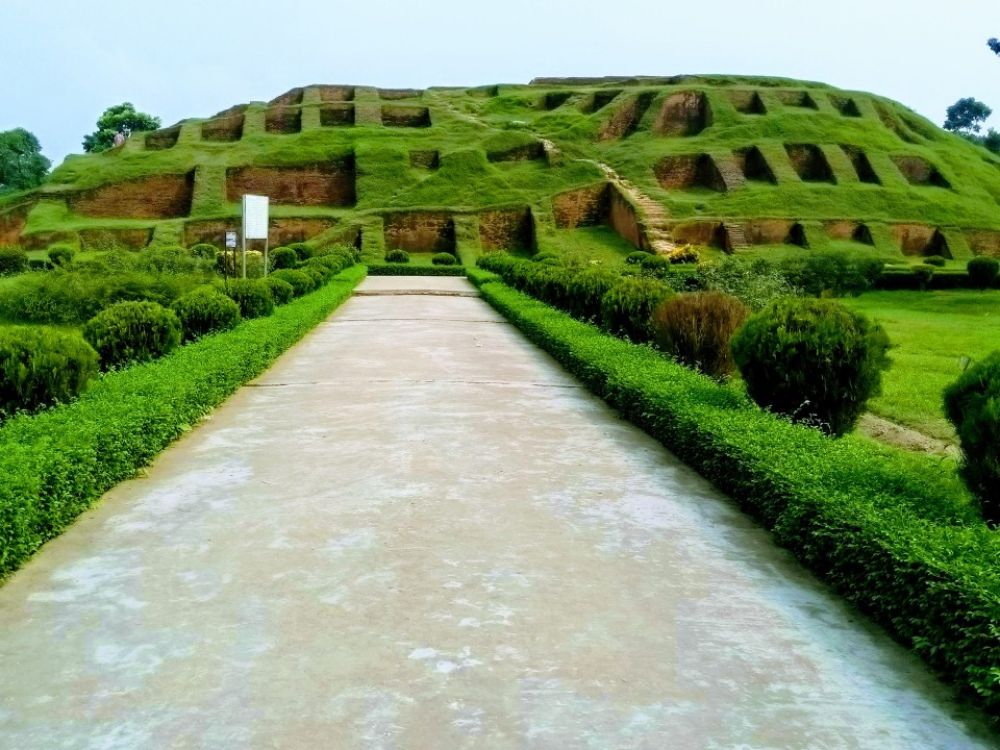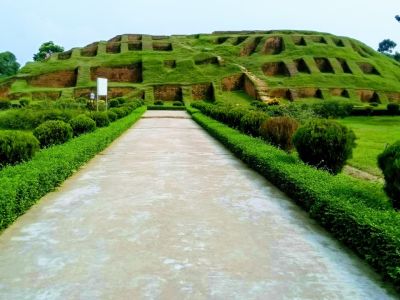

Embark on a journey back in time with a tour of Mahasthangarh, the oldest archaeological site in Bangladesh, which dates back to at least the 3rd century BC. Mahasthangarh was the ancient capital of the Pundranagara or Paundravardhanabhukti region and showcases the remnants of Buddhist monasteries, Hindu temples, and Muslim mosques. Visitors can explore the imposing citadel, with its thick brick walls, as they learn about the site's historical significance and its role in regional trade and politics. The area also includes the Mahasthan Museum, which houses a collection of artifacts recovered from the site, such as terracotta plaques, stone sculptures, and coins, offering a tangible connection to the region's diverse past. A professional guide can enhance the experience by providing in-depth knowledge and answering any questions about the ancient city.
Govinda Bhita, adjacent to Mahasthangarh, is an important archaeological site featuring the remnants of an ancient Hindu temple believed to have been dedicated to Lord Krishna. Visitors can explore the remains of the temple architecture and sculpture and contemplate the religious history of the region. This place offers a serene atmosphere where one can admire the old stone carvings and the intricate craftsmanship of the time. The site also provides stunning views of the surrounding landscape, including the Korotoa River, making it a perfect spot for history buffs and peace seekers. While there's not much left of the temple structure, the ambience and the age-old stories make the experience worth the visit.
In close proximity to the main Mahasthangarh site lies Bairagir Bhita, another testament to the region's archaeological wealth. Notable for the relics of a monastic complex, the area has revealed evidence of both Buddhist and Hindu influences through various excavated items including pottery shards, terracotta seals, and sculptural fragments. Visitors can walk the grounds, where ancient monks once meditated, and visualize the once-flourishing hub of religious and cultural activity. The site is relatively less crowded, offering a more contemplative experience. Explorations at Bairagir Bhita are often self-guided, so taking along informative booklets or hiring a local guide can significantly enhance the visit.
No visit to Mahasthangarh is complete without exploring its on-site museum, which serves as a cultural repository of the area's archaeological discoveries. The museum provides visitors with a rich narrative of the area's history through its exhibits of coins, terracotta artifacts, stone inscriptions, and ceramics. The displays are methodically arranged, giving a chronological perspective of the different periods. As visitors walk through the museum, they can gain insight into the daily life, religious practices, and artistic achievements of the civilizations that once thrived in the region. The museum is a must-see for anyone wanting to delve deeper into the history and cultural heritage of Mahasthangarh and its surroundings.
Not far from the main complex of Mahasthangarh is Gokul Medh, also known as Behula's Basar, the latter being a reference to the legendary heroine Behula from the ancient Bengali epic 'Manasamangal Kavya.' Gokul Medh is a significant historical mound which is believed to be the remains of a Buddhist stupa or a Hindu mandapa. The architectural features present within the mound trigger the imagination, leading visitors to ponder the stories and rituals associated with the site. The charm of Gokul Medh lies in its legends and the atmospheric settings which encompass both the mystery of the past and the tranquillity of the rural landscape.
A place shrouded in mystery, the Narapatir Dhap site is a part of the extensive Mahasthangarh area and is characterized by its unique archaeological features. Local legends suggest the site is associated with a king known for his excessive jewelry, with some tales indicating that his royal treasure might be buried here. While no treasure has been officially found, visitors can view the architectural remains, which include distinctive terracotta designs and structures indicating sophisticated urban planning. This site has fewer tourists, which makes it an ideal spot for those looking for a quiet exploration amidst historical ruins.
After exploring the relics and ruins of Mahasthangarh, visitors can unwind with a peaceful boat ride on the Korotoa River. This ancient river, which once played a pivotal role in commerce and transport for the city, now provides a serene experience as visitors can enjoy the lush landscape along its banks. A boat ride on the Korotoa is especially enchanting during sunset when the sky's colors reflect on the tranquil waters. It's a perfect way to end a day of historical exploration, as one reflects on the lives and activities of the people who once thrived along this very river.
Visitors to Mahasthangarh can take a historic walk along the remaining portions of the citadel wall that once defended the ancient city. While large segments of the wall have eroded over time, enough of it remains to give a sense of its original grandeur and strategic importance. The citadel, complete with its gates and bastions, offers a panoramic view of the surrounding countryside, including the remains of the ancient city's urban layout. Walking along the wall is a thought-provoking experience, prompting visitors to contemplate the complex history of conquests and daily life through the epochs that shaped this ancient metropolis.
Located within the Mahasthangarh archaeological region, the Parasuram Palace is a historical site that sparks the imagination with stories of kings and courtiers. Although what remains today are mostly ruins, visitors can still discern the layout of the royal residence and take in the atmosphere of its historical significance. The site narrates the saga of Buddhist influence juxtaposed with Hindu mythology, with some folk tales even naming the palace after the mythical sage Parasuram. Exploring the palace grounds opens a window into the noble life of ancient times and provides a hushed reprieve from the hustle of modern-day travel.
For the photography enthusiasts, Mahasthangarh offers an array of subjects, from the architectural details of ancient ruins to the pastoral landscapes of the surrounding countryside. A photography tour through this ancient city allows for capturing the timeless beauty of the area’s historical heritage, the daily life of the locals, and the natural settings that frame the archaeological site. Whether a professional photographer or an amateur, the intriguing shadows of the ruins at sunset or the vibrant colors of the local market will provide an array of opportunities to capture stunning images. Exploring the site through the lens of a camera can give an entirely new perspective to the historical experience.
